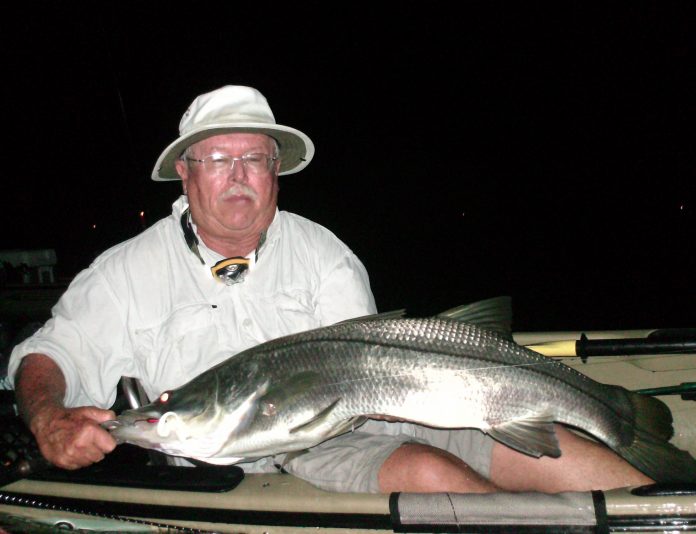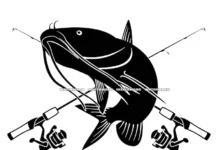May 30, 2012
Nighttime is one of the best times to target many species. For a solid stretch of the year, it is probably the best option for finding the most active fish. In summertime, the coolest the water will be is usually in the nighttime hours, particularly on incoming tides. With pre-dawn morning trips, once the sun is up, with every minute that passes opportunities diminish. With evening trips and into the night, every minute you are out there, the better the opportunities become. Inactive fish through the middle part of the day and afternoon get hungry and when the sun falls and disappears. If you like having areas all to yourself, night time is the right time for it. Safety is always “first” but enjoyable trips are to be had at night while the risks can be minimized.
Many people have a difficult time getting past “things that go bump in the night”, especially in the marine environment. Just as I was told when I had to sleep with the lights off when I was four “there’s nothing that’s there in the dark that isn’t there in the light.” The biggest sacrifice is vision, but evening trips are relaxing, serene, offer great fishing and are a much better option than baking in the sun June through September. Fears of sharks are illegitimate but use caution, there are plenty around and they are active in the shallows at night. Avoid unnecessary risks: Properly store fish that you are harvesting in a cooler or “fish bag” and never utilize a “stringer.” Sharks will take advantage of easy meal opportunities and you do not want a feeding shark connected to your kayak. To avoid other risks in darkness or murky waters, only dismount in areas that you inspect and always move around slowly if you are walking around in the water.
For nighttime outings, go to “places you know”. It is much better to go to familiar areas for nighttime trips. Carry your cell phone in a dry bag enabling communication should it be necessary. The other option for extreme emergencies and professional assistance is a VHF radio. Channel 16 is the emergency channel reserved for emergencies. A small handheld GPS unit is also excellent. A smart kayak angler will mark their launch and have the GPS available should they need satellite assistance in zero visibility conditions to safely return to the launch location. Under normal conditions, the angler should see “light landmarks” that help with knowing which way they are going and how to return to the launch. A compass kept in the crate is also useful for going the right direction.
Using a kayak, you must exercise some extra caution but with the right choices, it is a perfect way to do some nighttime fishing. The biggest objective is to stay out of areas that could see powerboat traffic. At times where you may be crossing areas you may encounter boats, it should be done with your kayak appropriately lit and with a more powerful signaling light available should a boat be heading in your direction. The savvy kayak angler is usually fishing in areas that if powerboats are going to enter, they will be doing so at minimum speeds. Always avoid setting up in boat channels or the center areas of passable bridges.
Headlamps by Princeton Tec are great investments, dependable and comfortable.
Lights are obviously an important item for nighttime fishing. Keep a headlamp readily available to help with tying knots or landing a fish. A 360 degree light is a great investment and makes you more visible from a distance, alerting others to your presence on the water. Rather than flashing your light in the eyes of an approaching vessel consider pointing the beam down into your cockpit of the kayak, illuminating yourself.
A 360 degree light, like this one by Yak Attack, is a “must have” for kayak anglers.
Whenever crossing a potential powerboat traffic area, turn on your headlamp, 360 degree light and use your “beam light” and flash both directions down the boat channel alerting any boats within visual distance of your presence. During times of being in these zones, your powerful beam flashlight should be immediately available. Mentioned already, a more powerful light gives some peace-of-mind that you can cast out a strong beam of light when you need to.
Have a strong light beam available for signaling or to illuminate yourself better for others to see.
All headlamps and lights are only useful with power. Spare batteries and an extra flashlight should be kept in a dry bag and stored in an easily accessible area of your kayak. These lights should be tested before trips for failures and battery strength. Backup lights should be available should you experience equipment failure on the water.
Lighting and storms are possible at any time in Florida but very likely in the summer months. Check the forecast and radar before you go but have someone you can call to get updates if you see any changes in the weather. Should there be lightning in the area, seek shelter (at a pre-chosen “safe area”) and lay all your rods down in the kayak. The best scenario is to get back to the launch location and in your car if there is sufficient time to load up and leave. With “pop up” storms, the safe location is something to utilize. It is way better to be sitting out a storm in a secure location than to be caught in open water during a squall.
For fishing at night, wear some eye protection, even if it is safety goggles. You lose sight of objects moving toward you. When a lure comes off a snag or out of a fish’ mouth, if it is from very close distances, it is come directly at your face. Eye injuries are very possible but preventable. Find comfortable eyewear to use during your daytime (polarized sunglasses) and nighttime fishing outings.
Getting out of the boat: Hard packed sand areas are best.
Use the paddle to test the depth, and presence of mud or oysters. The paddle can also be poked down on the bottom to scare off any stingrays you might step on when exiting the kayak. Same as with daytime trips, secure your paddle so that it does not exit your kayak and float away. If you have beached your kayak, drop the anchor anyway as rising tides, or a boat wake could wash your kayak off land and float off.
Other Useful items:
The handheld GPS (mentioned above) Can you find a location at night? Landmarks can be difficult to see after dark. A GPS is helpful if you don’t have another landmark (i.e.: point of an island, end of a sandbar). Great fishing locations that are in the middle of open areas are nearly impossible to find after dark. Mark the launch for help returning to areas you do not know as well. The other critical use for the GPS: Sea fog can take visibility to “zero”.
Flare gun- Not an item that you will need to utilize unless there is an extreme emergency, should you call for help and you know that the assistance is nearing, the flare gun will help the assistance team locate you much faster. Intercepting and catching nighttime species:
Big redfish, like this one caught by Craig, are often caught in the middle of the night.
The targeting of inshore species is slightly different than daytime outings. Where you go may be different than your daytime fishing locations. There are basic categories to fruitful fishing locations at night: Docks and bridges, passes, troughs, ambush points and the flats. There are seasonal patterns to nighttime fishing that affect location selection. Opportunities exist year-round but many anglers are making their after dark trips in the late spring, summer and fall. Lit docks and bridges are great locations to find the fish. The challenge is to get fish out from pilings when hooked. The passes have great water movement and natural “feeding stations” for many species. For the deeper bridges and the passes, heavier lures are necessary. The off-the-beaten-path areas are excellent. Troughs and flats with seagrass have terrific action. The relaxation of knowing you won’t see powerboats is serenity. Light lures usually work just fine but slightly heavier options are going to be useful in deeper areas with faster currents.
Weedless jigheads are helpful when working shallow, thick seagrass areas. The Edje jighead is perfect for rigging groove-bodied tails with the hook point hidden to reduce snagging on seagrass keeping a clean lure. “Weedless” also means treeless as well. Aggressive casts that overshoot the target area don’t hang up as it will with jigheads with exposed hooks. Color selection: Many of the same lures you use in daylight work well at night. For your nighttime selections, also include oddities like pink-silver glitter, silk chartreuse, black or other very dark shades. Lure presentation is always important and this is no different at night. Realistically swim lures to represent the bait style you have chosen. Swim your “swimbaits” and glide the shrimp style tails like the SlamR for best results. Twitches to mimic startled baitfish will often help to create strikes. The advantage of “Incoming tides”
In the wintertime, the outgoing tides have warmed waters, beneficial to fishing. Superheated waters from the daytime solar heating on the outgoing tides are often poor times to fish. Incoming tides will usually have cooler, higher oxygenated water in the warmest months. Check your tides and you will often see that big low tides coincide with sundown during the summertime months, so the incoming water is usually a very active time for inshore species.
Don’t miss out on the best opportunities summer has to offer for fishing the Tampa Bay area! If it is not something you are comfortable doing, take advantage of a Strike Three Kayak Fishing trip and let me make you comfortable fishing in the dark.
- The Neil Blog… - July 26, 2023
- The Catfish - July 26, 2023
- update - July 22, 2023











